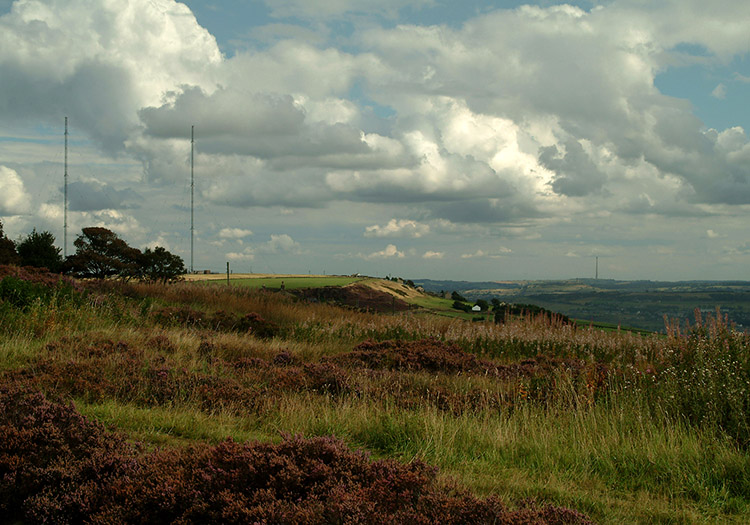
A Passion for Radio.
Part I.
By Ian Walker. U.K.
Introduction.
Many who read Micscape will know I am interested in microscopes and written a number of articles regards the restoration of them and bringing them back to good working order.. sometimes, but not always, to write about and then sell on as it's the refurbishment that interests me most. This is a secondary hobby whilst bygone radio is another of my other interests along with recorded music [vinyl] and its associated reproduction equipment. I am not talking about 'black box' amateur radio transceivers bristling with knobs and digital signal processing [DSP] or DAB [digital audio broadcasting] but analogue radios of the past which had heart and soul and the broadcasting techniques of those eras.
As Micscape now has an off shoot 'Micscape Lite' covering a wider range of interests I thought I would share some of my times in the professional field when I worked for BBC Transmitter Group giving some background to the broadcasting industry leading nicely onto one or two of the old radios I have restored in part II which follows next month.
The Early Days.
I got my interest in electronics from my father who worked in the industry, when I was young I would overlook the work he did repairing old black and white TV's and radios that people brought to him with faults which in the early days where mainly valve, ran hot and could be unreliable. From the interest I showed he shared further projects with me as I learnt the art of repairs, soldering and fault finding. As many kids in the early 60's followed fashion, the Beatles and the Rolling Stones, I spent my pocket money visiting government surplus shops in Hull selling off old electronic boards for a few pence and buying components from shops in the back of Wireless World and Practical Wireless. I have built a good number of circuits over the years!
Time moved on and I went to college to train as a Radio Officer [Marine Radio Certificate and Radar courses] and in my spare time cramming in City & Guilds Telecom's courses, however by the time I finished these, automation of safety equipment at sea and CW [Morse] becoming less important meant the radio officer as a dedicated post was becoming redundant so I did the next best thing and joined the BBC in 1979.
The BBC Years.
The BBC in November 2012 celebrated 90 years of regular radio broadcasting, from small beginnings of the British Broadcasting Company in the 1920's promoting radio sales for manufacturers by starting regular broadcasts to a large Corporation it is today.
I was fortunate to work at a few of the stations before the old transmitters and buildings had gone. Part of the job training for an engineers post meant attachments all over the country to places like Daventry and Droitwich which are heaped in British broadcasting history. Daventry started as a 25kW long wave transmitting station in 1925 with the prefix 5 XX, a transfer to this permanent site after experiments in Chelmsford with the same prefix but when I was there it was used as a short wave station but I have a vague memory that the redundant 5 XX building was still standing in a quiet part of the aerial field in 1980 but I could be wrong! In 1927 a medium wave transmitter was completed on the site with the prefix 5 GB making Daventry the first twin waveband site in the world.
Shortwave stations like Daventry, Skelton near Penrith and Woofferton in Shropshire in the 1980's operated fairly 'modern' Marconi transmitters and RF output powers were substantial at 100 to 250kW from each transmitter depending on design. It was all 'hands on' with these transmitters with 'wave changing' throughout the day on different short wave bands replacing 'coils' for different wave bands in selected tuned circuit positions in the transmitter. These included substantial heavy anode coils some as thick as a mans' arm and chest high with normally only a few minutes to re-tune several stages ready for the next broadcast. It was hot work in the summer as the enclosures although air cooled while powered still remained very warm when you climbed inside. The large transmitting valves used a sophisticated steam cooling system called vapour phase cooling.
A little story about Woofferton.
At the time in the early 1980's when I was at Woofferton it carried V.O.A [Voice of America] transmissions on the short wave transmitters. An extensive aerial field [grass covered] spread over many acres housed a host of masts and aerial systems and part of our job was to adjust the beam pattern of these aerials by moving feeder links with a long insulated pole. This included working in the early hours in pitch black darkness with only a head torch for illumination.
Due to the high radio frequency field strength of all the arrays, pick-up was inevitable as you pulled one link off with your pole and affixed to another position, this all at a height above head level. Little narrow paths joined different numbered aerial arrays and a card system you took out for that time period told you which array to go to day or night. Even though we were in radio contact when it was safe to do the 'quick switch', large sparks often trailed off the end of the link you were moving with your pole, these changes were quite labour intensive as heavy cable feeds dangled off the end of your pole.
We used to get around the large aerial field by bicycle doing several of these aerial adjustments in different parts of the aerial field in fairly quick succession, an error on a powered aerial system would be rather dire. One time very heavy rain had been going on for a good long while and the whole aerial field was under water in total darkness and my bike and me were getting lost, I hadn't a clue where the cycle paths were. Eventually coming up and over the top of my wellies... I had to abandon the mission and other arrangements were made for the transmissions that night!
One of the spookiest things though was we shared these aerial fields with a farmer's sheep so as your head torch floated about rather randomly pedaling along, dozens of luminous eyes would suddenly catch the light, the Woofferton site was in a rural area and very dark...strange swirling ground mists often occurred making it even more eery. A full fog could mean you could get disorientated whilst coughing sheep sounded mighty ghostly when all alone out there. It was great to get back indoors into the warmth again on a foggy winters night! There was one bonus though the stars looked magnificent on a clear night.
A sad end.
BBC transmitter group was sold off in the 1990's probably to raise funds for the digital switch over from analogue colour 625 line TV to the new digital services. Short wave stations originally operated by BBC staff came under new companies and management and in the same era other departments of the BBC were closed including outside broadcast units and the BBC radiophonic workshop that created music and sound effects for BBC programs. After the BBC I worked for a few years in the commercial sector of broadcasting but tight time schedules and greater working pressures did not suit my style.
Moorside Edge.

A fairly up to date picture of the twin masts of Moorside Edge transmitting station, in the background is the free standing concrete tower of Emley Moor [a good number of years ago the previous open lattice structure failed and collapsed in a storm], if you are at the top in a wind it rocks side to side quite alarmingly! Emley Moor is mainly used for transmitting both BBC and independent commercial TV for the northern region, recently this has been re-engineered for digital TV and the older transmitters for colour 625 line analogue TV were shut down.
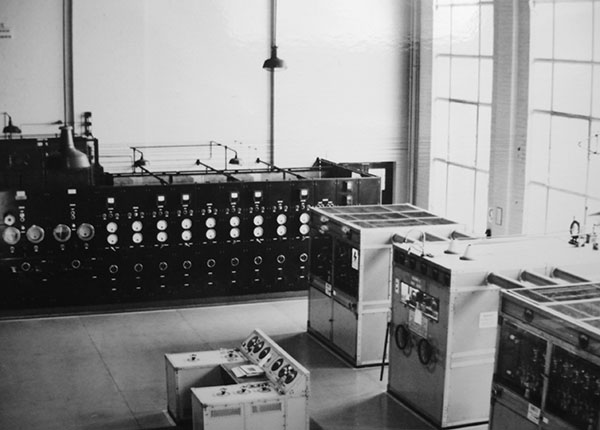
Situated on the north Pennines not far from Huddersfield is Moorside Edge at 1100 feet above sea level. The site is still there today transmitting medium wave broadcasts including Radio 5 'Live' but not the grandiose building or transmitters of the 1930's shown here which was demolished in the 1980's but now a brick and corrugated metal box!
The above picture taken by me high up on a balcony shows part of the Marconi transmitter hall and switchboard of the old station at Moorside Edge, then called the Northern Regional Transmitter. Originally this provided two services, the national program transmitting on 301m at 50 kW and the regional program on 479m also 50kW. When it came into operation it caused a lot of problems for local listeners with crystal wireless sets as these are very unselective and the power drowned out other stations on medium wave.
The design was based on Brookmans Park which was opened in 1930 and called the London Regional Transmitter serving London and the south east. This site went into operation in 1931, I along with many others before me operated these old transmitters [T1 & T2] in my early years in BBC transmitter group. I still live just a short bike ride away. Now very old these transmitters were used as back up in case of failure of either the main Radio 4 2x Marconi MWT 150 kW [T3A & T3B] and Radio 1 RCA 50E 50 kW [T4] transmitters and were not in continuous use but once a week they were powered up to check all was OK if needed.
At the control desk adjustments could be made as well as turning on and off the transmitter. The transmitter sections were split up into aluminium, steel and glass clad modules, the high power radio frequency valves being water cooled whilst lower power valves were air cooled.
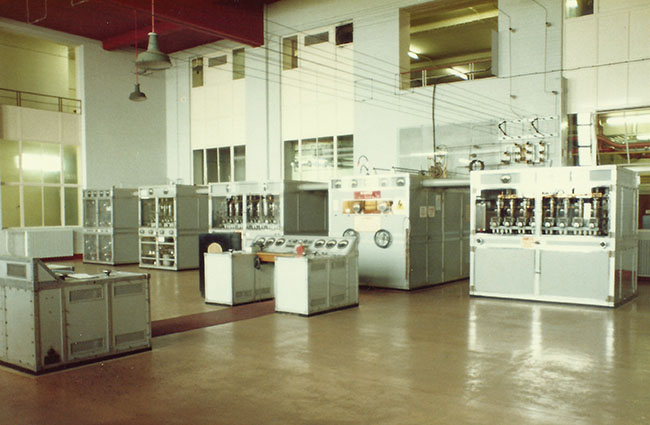
A splendid view of the old Marconi transmitter hall at Moorside Edge taken by a friend of mine who worked there at a similar time to me, notice the open feeder construction above the transmitters. As these transmitters were not in use there was a nice sense of peace and tranquility!
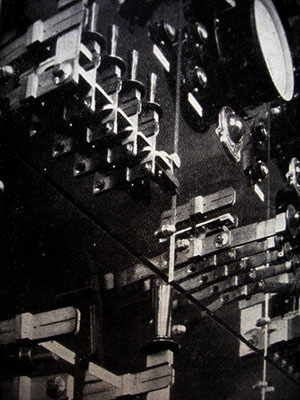
Close-up of the main switchboard from Brookmans Park.
Part of the old switch gear from Brookmans Park on which Moorside Edge building and transmitters were based. This is a photograph taken from the BBC Year Book 1931, these technical handbooks were written for many years and excellent resource for British broadcasting and also contain interesting adverts for radio equipment of the time. I have the 1928 [then called the BBC Hand Book 1928] along with a few others, the blue 1943 book shown later was much slimmer and poorer paper for war time economy reasons.
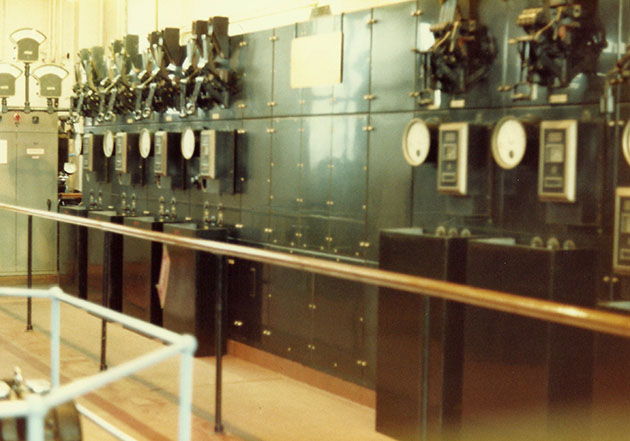
Part of one of the old switchboards at Moorside Edge, note the big meters high up on the left.
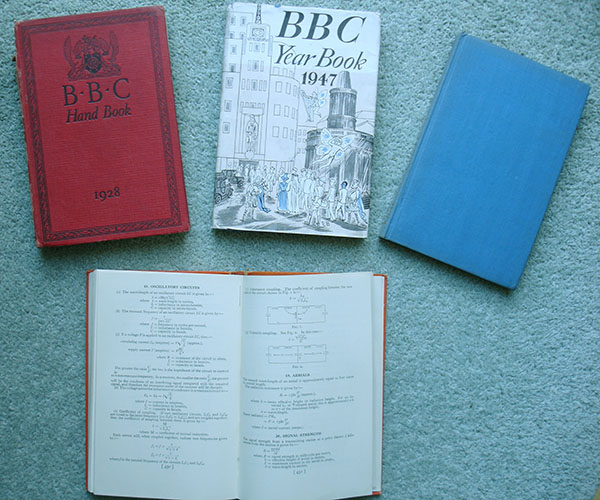
Typical early BBC year books, the early ones in particular are quite technical giving details of studio, outside broadcast and transmitting techniques together with radio theory.
The old building at Moorside Edge was light and airy being elegant, well designed and constructed, sadly I have no external pictures of the building itself. Bringing the HT and valve filaments online was something of an art form and had to be well learnt for safety reasons, something akin to a Frankenstein film as big brass insulated levers on the switchboard brought the direct current [DC] voltages slowly up ready to power up the main transmitter sections, high voltages and large currents for the filaments were the order of the day, great stuff. These operations would not pass health and safety regulations of today!
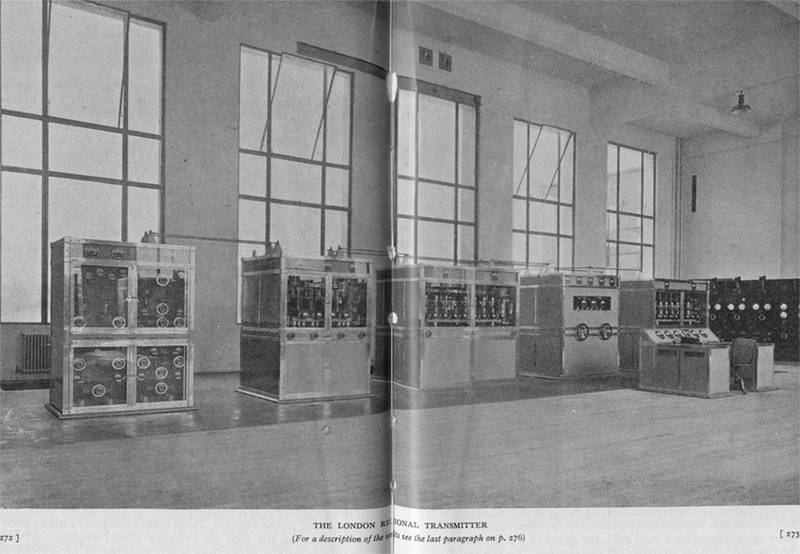
Part of Brookmans Park Marconi medium wave transmitter hall from the BBC Year Book 1931, very similar to Moorside Edge.
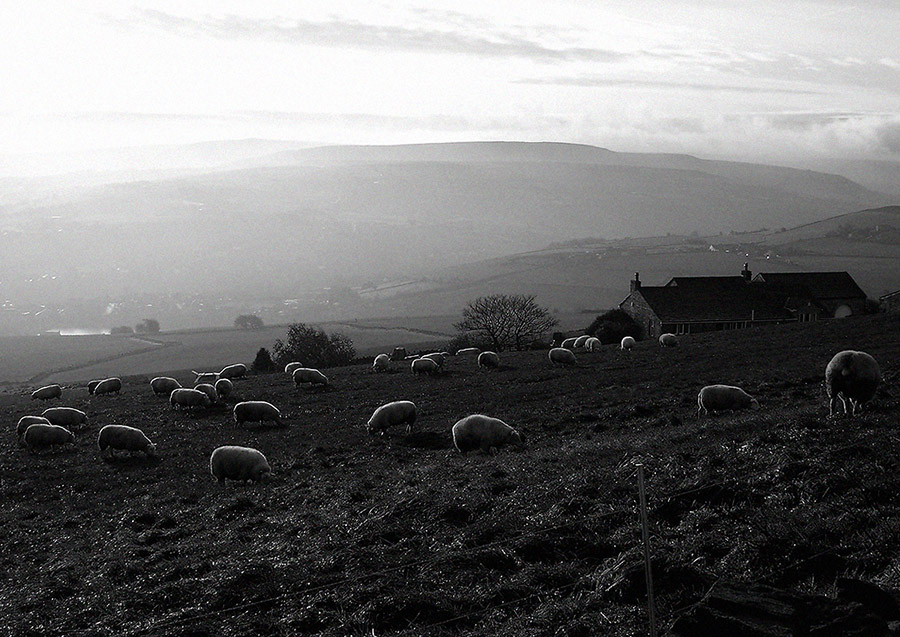
The surrounding hills of Moorside Edge are peppered with remote farm cottages, bad weather and snow is the norm' in past winters but recently the weather has been more of rain and generally milder. Here an early morning shot captures the mood.
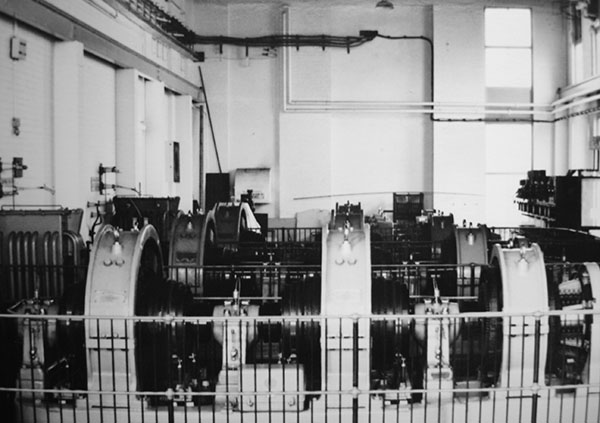
Some of the DC motor generators for the old Marconi 50 kW transmitters.
Three machines each capable of producing 1300 Amps at 23V fed valve filaments whilst three door inter-locked high voltage generators provided 10000-11000 Volts [10kV-11kV] feeding the anodes of the output valves and lesser generator sets provided lower voltages and currents for intermediate stages in the transmitters.
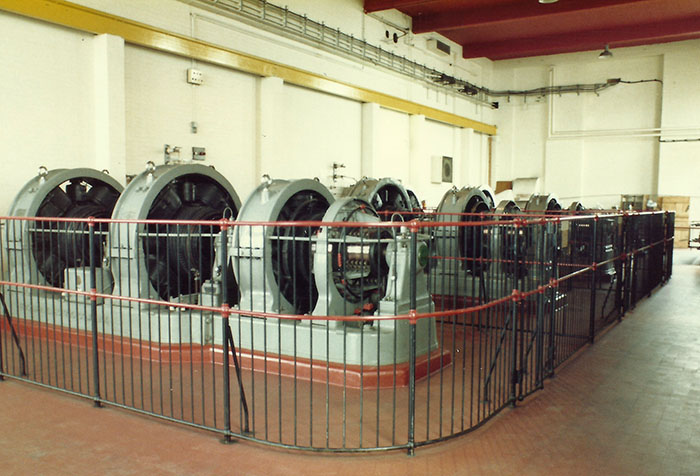
High Voltage DC motor generator sets at Moorside Edge.
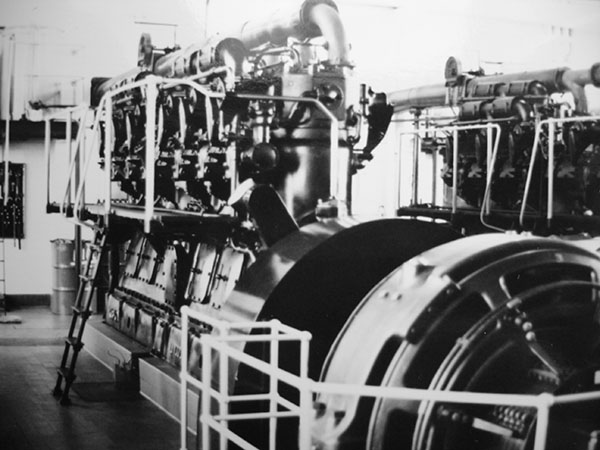
Part of the diesel generator plant for the old Marconi transmitters [T1 & T2] around 1980, a sense of scale can't really be judged here except perhaps for the climb up ladder which is about five feet high, large fuel oil tanks could keep these running for a long time if needed.
In the original specification the four 6 cylinder diesel engines in turn spun 220 Volt DC generators each capable of an output of 200kW to feed the motor generator sets for the old Marconi 50 kW transmitters, some of which can be seen in the previous photographs, this part of the site being all DC, we always reckoned the roast beef and Yorkshire puds' that were cooked in the oven on this DC bus tasted better for it! Newer transmitters then providing the main services for Radio 1 and Radio 4 [T4, T3A & T3B respectively] were powered by AC feed into the station. In turn these transmitters have gone when the new building was built in the 1980's.
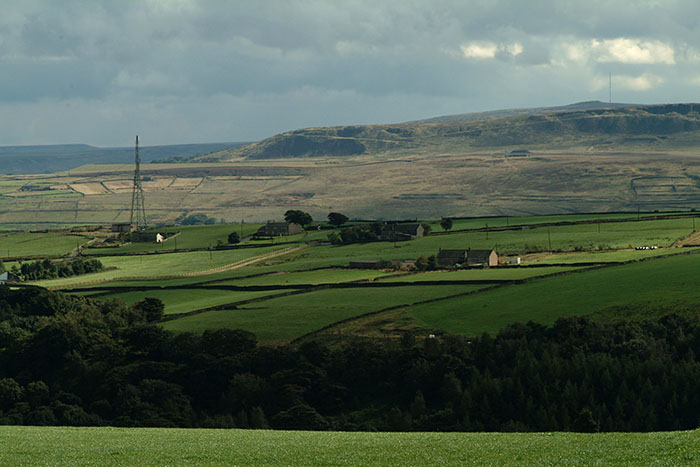
A typical unmanned relay station in the foreground near Moorside Edge called Cop Hill, this houses TV 'transposer' equipment receiving the TV signals from Emley Moor and re-broadcasting them on other selected TV channels, these transposers of several different power levels and mast types are dotted all over the area 'filling in' weak signal areas to local communities. The BBC and IBA as they were then in the 1980's share the buildings but have their own secure rooms within for their respective gear. In the background against the skyline Holme Moss mast can be seen giving an idea of its remoteness on the Pennine 'tops'.
Droitwich.
Droitwich is in Worcestershire and the station opened in 1934 superseding Daventry's BBC national program service long wave 5 XX station which had been running since 1925 but on a new frequency of 1500KHz or 200m, Daventry continued with the midland regional program on medium wave until 1935 until the new installation at Droitwich took over making this now the new twin wave service. None of the oldest gear was there when I had an attachment in the early 1980's, the transmitter and control room shown here will have long gone now. A good number of the big sites like Holme Moss, Moorside Edge and Droitwich were all manned for many years but reliability and modern techniques in broadcasting mean that these sites are no longer populated, if a fault occurs it is a 'call-out' now for an engineer.
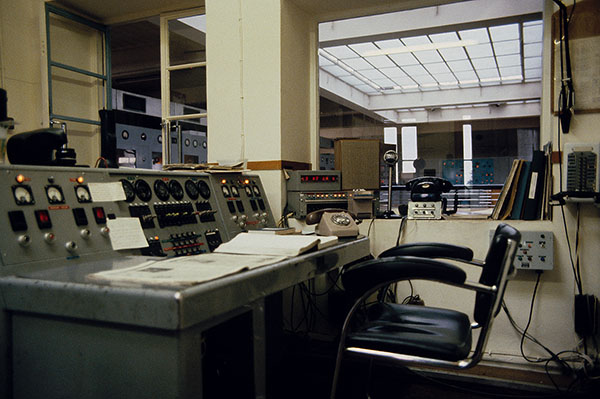
The old control room, this area was partitioned off from the transmitter hall.
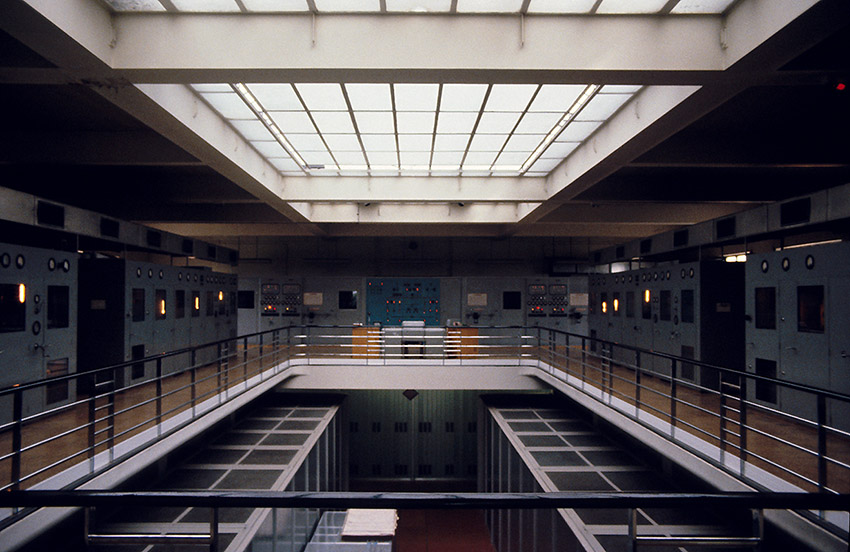
The main transmitter hall at Droitwich in the early 1980's based on two levels with the RF transmitter cabinets on the upper floor with ancillary equipment below. Identical systems allowing one side to be safely isolated and worked on whilst still keeping the service in operation.
BBC Radio 4 is transmitted on long wave today, originally this was on 1500m or 200KHz, now offset to 198KHz, [1500m has been used in the past for the BBC 'light service' roughly equivalent to BBC Radio 2 today] the coverage is large including central and northern areas of England. The audio quality is excellent on my Hacker radio and I prefer the sound to the equivalent VHF FM service for speech programs which predominate on this service and enjoy TMS [cricket test match special] which is still transmitted on Radio 4 long wave when matches are on now augmented with digital services.
Holme Moss.
After numerous attachments around the UK this became a home base for me for a good number of years. Holme Moss opened in the late 1950's and is situated high up on the Pennines around 1700 feet above sea level. From here a large area was covered by engineers maintaining not only the VHF FM transmitters on site at Holme Moss [and in its early years the black and white 405 line transmitters] but many different types of sites from as far as Belmont in Lincolnshire to Skipton much further north. The work was extremely varied and in those times we were also a base for specialist repairs to component level for modules and units coming from other parts of the country, a job I liked.
Hard winters were the norm' in the 1980's and quite a few times we were snowed in for more than 24 hours until a relief team were sent walking up from Holme village and it's a steep climb from there up to the top, especially in deep snow, at these times a skeleton crew of only a few engineers and senior engineer would be kept on site, evacuating the remainder before conditions became too bad to get out by four wheel drive vehicles or if possible by our bus.
In the winter-spring of 1986 as the old mast was going to be dis-assembled and the new slimmer version was already in use, ice storms raged for a good few weeks causing severe icing of the masts and stays, the latter are greased to allow ice and snow to slip down without the weight exceeding the breaking strain of the multi-cored steel wires that make up the stays. The icing became so severe that at one point it was touch and go whether both masts would be lost under the severe weight they were under. The following pictures give an idea of the winters of the 1980's at Holme Moss.
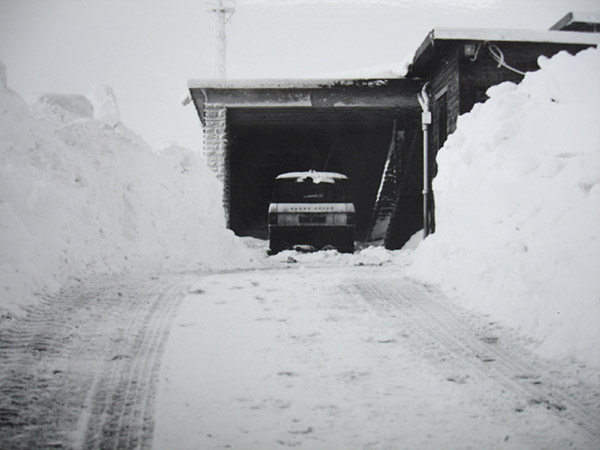
A four wheel drive Range Rover parked outside the old parking bay at Holme Moss, a picture from a bad winter in the early 1980's. A snow blower has managed to get up and cleared a track for us to get in and out, often at these times TV sites based in remote areas of Derbyshire were more likely to be suffering faults but all efforts were made to get to them if they were shut down.
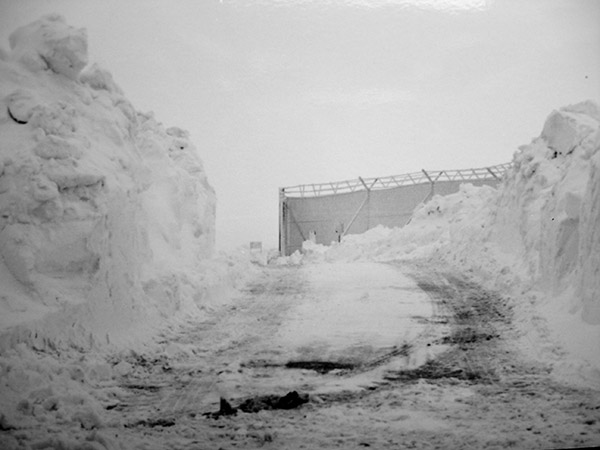
This picture is facing the opposite way from the previous looking out onto the entrance and drive, the security fence is in the region of 12 feet high giving an idea of how much snow there was to clear.
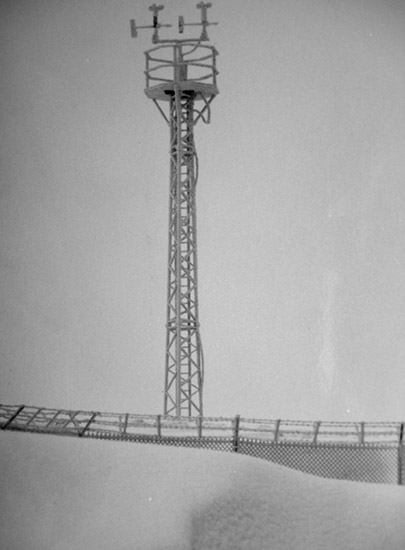
A large snow drift building up against the security fence.
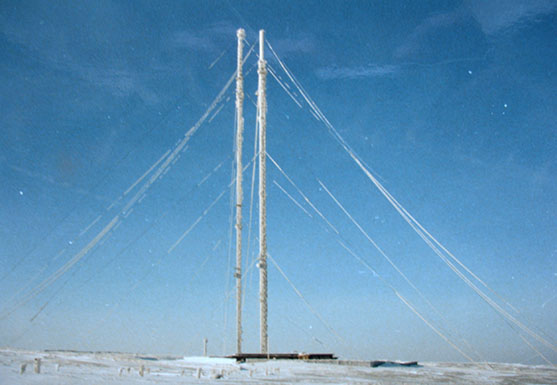
Ice build up at Holme Moss in 1986.
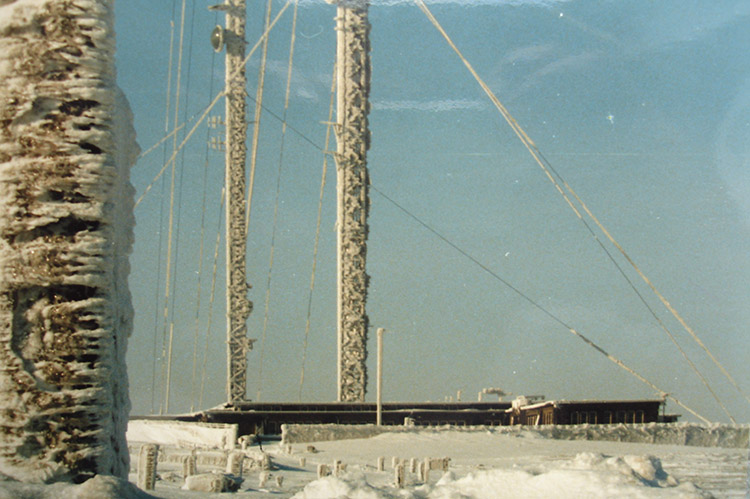
The ice storms of 1986 nearly brought down both the old and new masts under the severe weight of snow and ice build up. The older mast is the thicker of the two shown here, the main building can be seen peeking up above the snow and security fence. At its peak a total of around 50-60 people were based here including the site manager, secondary managers, aerial staff, office and cleaning staff and of course the all important cook who kept us well fed when at base along with engineers, senior engineers and engineers in training. Different allocations were by rota's so at any one time there would be mobile maintenance teams, fault teams and base engineers.
The total number never appeared at any one time but shift patterns were in place including working to the end of programs to the early hours before 24 hour continuous broadcasting became the norm'. This was the main base for the repair and maintenance of many sites based in Yorkshire and Derbyshire and some further away like Belmont in Lincolnshire. With modern technology and improved reliability of equipment it is now un-manned.
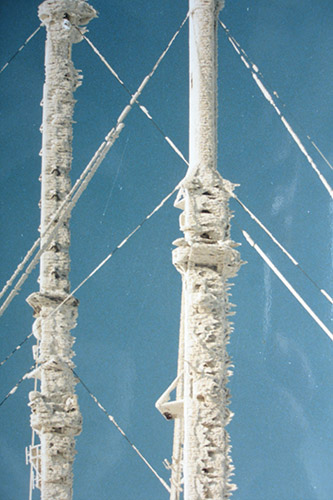
This picture is directed at the top of the 700 foot masts were the aerial systems are housed, it is barely possible to see the VHF aerial structures that are normally visible on the new mast on the left. The transmitters were struggling to keep on as the ice affected them, for a good while they sat on reduced power output.
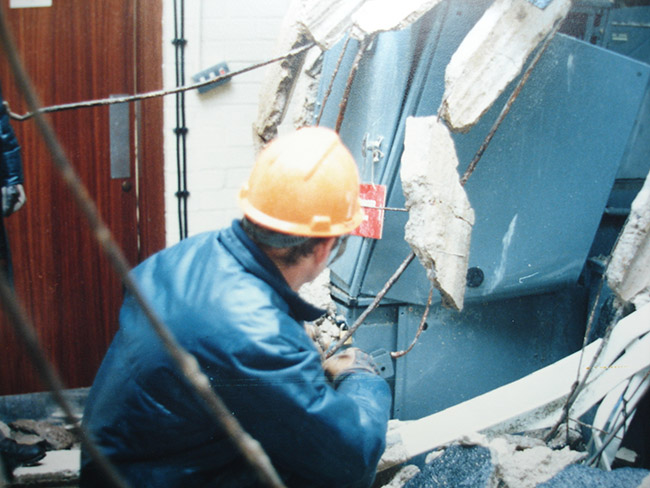
In the aftermath an engineer assesses the damage to transformers and switch gear caused by ice blocks crashing through the reinforced concrete roof, by the time very large chunks of ice weighing many hundreds of pounds began falling from the masts the site was pretty much evacuated as danger to life became a real possibility, I was one of the last to leave before it became just too dangerous to remain on site. The situation was reported on the TV local news at the time.
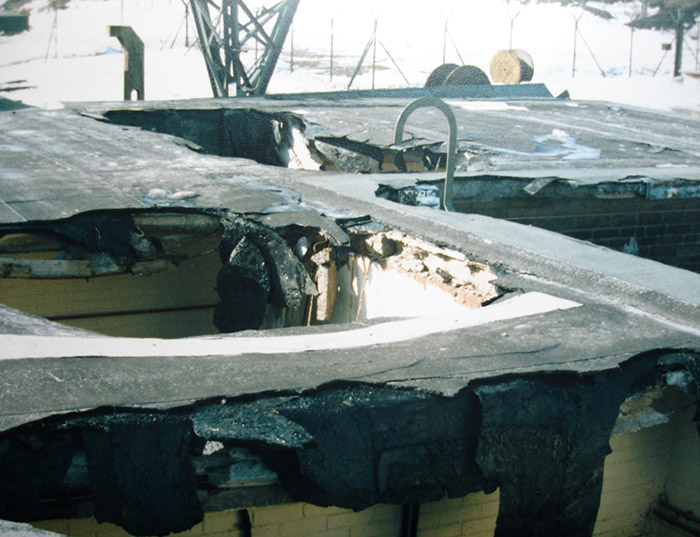
Damage to the roof of Holme Moss transmitting station from blocks of ice falling from the masts.
I hope I have given a flavour of what broadcasting was like some 30 years ago as I write in December 2012 when some of the oldest sites like Moorside Edge were still housing original Marconi medium wave transmitters. This takes me nicely onto next month's topic on some of the old radios that can be bought cheaply and brought back to good working order. I will leave you a picture of before and after of a Dynatron radio bought for a few pounds on eBay, a very sad little radio it was too but I knew it could look good after some TLC.
Next month.
Dynatron MW LW 'Nomad' transistor portable ca.1959 bought from eBay for a few pounds as a restoration project.
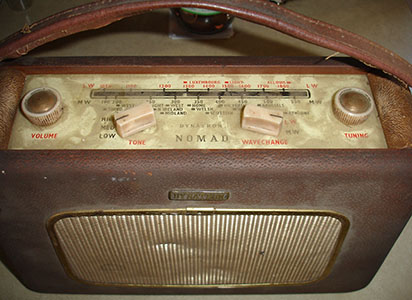
Before.
Filthy in all departments but it still has potential!
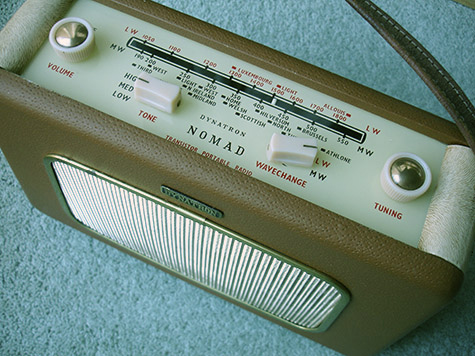
After.
Restoration completed it looks a lot better with good sound too. All original, nothing has been replaced except the new stitching in the strap!
Suggested reading for British Broadcasting and radios, plenty of information is available to download on the web too:
The old BBC year books can be sourced on abe.books.co.uk. or .com. Detailed information on broadcasting, well illustrated with pictures and schematics and technical theory together with interesting adverts of the time.
Radio Radio written by Jonathan Hill, an excellent book covering radio technology from the crystal sets and early valve gear of the 1920's all the way through to when transistor table top VHF FM stereo sets came into operation. Lots of technical information and black and white pictures, also includes names of stations and frequency allocations and how they changed through the MW LW bands over the decades.
Comments to the author Ian Walker welcomed.
Published in the December 2012 edition of Micscape.
Please report any Web problems or offer general comments to the Micscape Editor .
Micscape is the on-line monthly magazine of the Microscopy UK web site at Microscopy-UK
©
Onview.net Ltd, Microscopy-UK, and all contributors 1995
onwards. All rights reserved.
Main site is at
www.microscopy-uk.org.uk.